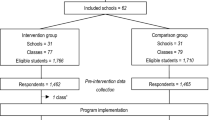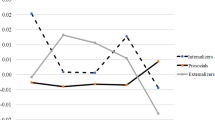Abstract
Purpose
During adolescence, adolescents are more susceptible to internalizing and externalizing problems influencing quality of life (QoL). The purpose of the study is to verify the effectiveness of a peer education on improving QoL of adolescents.
Methods
A cluster randomized controlled trial (RCT) was conducted involving 1564 subjects who were divided into an intervention group (n = 714) and a control group (n = 850). The intervention group received 1-year peer education. Their QoL and basic information were assessed using a Adolescent Quality of Life Scale and a self-designed basic situation questionnaire.
Results
After the intervention, significant increases were found in the psychological, and social, pubertal dimensions, and in total QoL (P < 0.05) in the intervention group relative to the control group. Significant decrease was found in physical dimension (P < 0.05), but the change in the intervention group (0.74 decrease) was much less than that in the control group (1.94 decrease). The improvements of physical (B = 1.215, SE = 0.305, P < 0.001), psychological (B = 1.496, SE = 0.598, P = 0.013), pubertal (B = 0.828, SE = 0.244, P = 0.001), and total (B = 3.455, SE = 1.429, P = 0.016) QoL in the intervention group were higher than in the control group in mixed model.
Conclusions
The peer education based on adolescent health education is effective in improving the physical, psychological, pubertal, and total QoL of adolescents, but no social QoL.

Similar content being viewed by others
References
(1995). The World Health Organization Quality of Life assessment (WHOQOL): Position paper from the World Health Organization. Social Science & Medicine, 41(10), 1403–1409.
Shrivastava, S. R., Shrivastava, P. S., & Ramasamy, J. (2013). Childhood and adolescence: Challenges in mental health. Journal of the Canadian Academy of Child and Adolescent Psychiatry,22(2), 84–85.
Riazi, A., Shakoor, S., Dundas, I., Eiser, C., & McKenzie, S. A. (2010). Health-related quality of life in a clinical sample of obese children and adolescents. Health and Quality of Life Outcomes,8, 134.
Mirghafourvand, M., Charandabi, S. M.-A., Sharajabad, F. A., & Sanaati, F. (2018). Religious practice and health-related quality of life in iranian adolescent girls. Journal of Religion and Health,57(3), 796–806.
Cumming, S. P., Gillison, F. B., & Sherar, L. B. (2011). Biological maturation as a confounding factor in the relation between chronological age and health-related quality of life in adolescent females. Quality of Life Research,20(2), 237–242.
van der Cruijsen, R., Murphy, J., & Bird, G. (2019). Alexithymic traits can explain the association between puberty and symptoms of depression and anxiety in adolescent females. PLoS ONE,14(1), e0210519.
Oldehinkel, A. J., Verhulst, F. C., & Ormel, J. (2011). Mental health problems during puberty: Tanner stage-related differences in specific symptoms. The TRAILS study. Journal of Adolescence,34(1), 73–85.
Rogol, A. D., Roemmich, J. N., & Clark, P. A. (2002). Growth at puberty. Journal of Adolescent Health,31(6), 192–200.
Sheehy, A., Gasser, T., Molinari, L., & Largo, R. H. (1999). An analysis of variance of the pubertal and midgrowth spurts for length and width. Annals of Human Biology,26(4), 309–331.
Marcell, A. V., Allan, E., Clay, E. A., Watson, C., & Sonenstein, F. L. (2013). Effectiveness of a brief curriculum to promote condom and health care use among out-of-school young adult males. Perspectives on Sexual and Reproductive Health,45(1), 33–40.
Schleider, J. L., Ye, F., Wang, F., Hipwell, A. E., Chung, T., & Sartor, C. E. (2019). Longitudinal reciprocal associations between anxiety, depression, and alcohol use in adolescent girls. Alcoholism-Clinical and Experimental Research,43(1), 98–107.
Reardon, L. E., Leen-Feldner, E. W., & Hayward, C. (2009). A critical review of the empirical literature on the relation between anxiety and puberty. Clinical Psychology Review,29(1), 1–23.
Akca, O. F., Vural, T. A., Turkoglu, S., & Kilic, E. Z. (2015). Anxiety sensitivity: Changes with puberty and cardiovascular variables. Pediatrics International,57(1), 49–54.
Angold, A., Costello, E. J., & Worthman, C. M. (1998). Puberty and depression: The roles of age, pubertal status and pubertal timing. Psychological Medicine,28(1), 51–61.
Palacio-Vieira, J. A., Villalonga-Olives, E., Valderas, J. M., Espallargues, M., Herdman, M., Berra, S., et al. (2008). Changes in health-related quality of life (HRQoL) in a population-based sample of children and adolescents after 3 years of follow-up. Quality of Life Research,17(10), 1207–1215.
Mendle, J., Harden, K. P., Brooks-Gunn, J., & Graber, J. A. (2010). Development’s tortoise and hare: Pubertal timing, pubertal tempo, and depressive symptoms in boys and girls. Developmental Psychology,46(5), 1341–1353.
Bravender, T. (2015). Adolescents and the importance of parental supervision. Pediatrics,136(4), 761–762.
Ibanez, L., Ferrer, A., Marcos, M. V., Hierro, F. R., & de Zegher, F. (2000). Early puberty: Rapid progression and reduced final height in girls with low birth weight. Pediatrics,106(5), e72.
Fang, Q., Wang, H., Cao, X., & Chen, H. (2012). Puberty timing status and its correlation with childhood obesity in Chongqing City. Journal of Hygiene Research,41, 562–565 (in Chinese).
Dimler, L. M., & Natsuaki, M. N. (2015). The effects of pubertal timing on externalizing behaviors in adolescence and early adulthood: A meta-analytic review. Journal of Adolescence,45, 160–170.
Deardorff, J., Cham, H., Gonzales, N. A., White, R. M. B., Tein, J.-Y., Wong, J. J., et al. (2013). Pubertal timing and Mexican-origin girls’ internalizing and externalizing symptoms: the influence of harsh parenting. Developmental Psychology,49(9), 1790–1804.
Carter, R., Jaccard, J., Silverman, W. K., & Pina, A. A. (2009). Pubertal timing and its link to behavioral and emotional problems among ‘at-risk’ African American adolescent girls. Journal of Adolescence,32(3), 467–481.
Li, C., Wang, H., Cao, X., Gou, M., & Zhang, Z. (2013). Depressive symptoms and its related factors among primary and middle school students in an urban-rural-integrated area of Chongqing. Journal of Hygiene Research,42(5), 783–788 (in Chinese).
Evcili, F., & Golbasi, Z. (2019). The effect of peer education model on sexual myths of Turkish university students: An interventional study. Perspectives in Psychiatric Care,55(2), 239–248.
Seymour, J. E., Almack, K., Kennedy, S., & Froggatt, K. (2013). Peer education for advance care planning: Volunteers’ perspectives on training and community engagement activities. Health Expectations,16(1), 43–55.
Khan, N. A., Nasti, C., Evans, E. M., & Chapman-Novakofski, K. (2009). Peer education, Exercising, and Eating Right (PEER): Training of peers in an undergraduate faculty teaching partnership. Journal of Nutrition Education and Behavior,41(1), 68–70.
Huo, N., Yue, Y., Song, X., Xu, X., & Jiang, F. (2011). Practice models of peer education used to AIDS/HIV prevention education in university students. Medicine and Society,24(1), 59–61. https://doi.org/10.3870/yxysh.2011.01.021(in Chinese).
Bulduk, S., & Erdogan, S. (2012). The effects of peer education on reduction of the HIV/sexually transmitted infection risk behaviors among Turkish University students. JANAC—Journal of the Association of Nurses in Aids Care,23(3), 233–243.
Ngo, A. D., Ha, T. H., Rule, J., & Dang, C. V. (2013). Peer-based education and the integration of HIV and sexual and reproductive health services for young people in Vietnam: Evidence from a project evaluation. PLoS ONE,8(11), e80951.
Allicock, M., Carr, C., Johnson, L.-S., Smith, R., Lawrence, M., Kaye, L., et al. (2014). Implementing a one-on-one peer support program for cancer survivors using a motivational interviewing approach: Results and lessons learned. Journal of Cancer Education,29(1), 91–98.
Liu, Q., Liu, L., Vu, H., Liu, X., Tang, S., & Wang, H. (2015). Comparison between peer-led and teacher-led education in tuberculosis prevention in rural middle schools in Chongqing, China. Asia-Pacific Journal of Public Health,27(2), NP2101–NP2111.
Li, J., Wu, R., Sun, B., Liu, Q., & Wang, H. (2014). Short-term effect of peer education intervention on sub-health among left-behind middle school students in a reservoir of Chongqing. Chinese Journal of School Health,35(4), 561–563. https://doi.org/10.16835/j.cnki.1000-9817.2014.04.030(in Chinese).
Wan, X., Li, Z., & Liu, J. (2007). Sample size estimation in clinical studies: (1) clinical trials. Journal of Traditional Chinese Medicine,48(6), 504–507. https://doi.org/10.13288/j.11-2166/r.2007.06(in Chinese).
Dong, F., Li, C., Peng, X., & Qin, H. (2009). Significance, calculation methods and precautions of sample content calculation in clinical research. Chinese Journal of Stroke,4(10), 854–859 (in Chinese).
Joinson, C., Heron, J., Lewis, G., Croudace, T., & Araya, R. (2011). Timing of menarche and depressive symptoms in adolescent girls from a UK cohort. British Journal of Psychiatry,198(1), 17–23.
Negriff, S., Hillman, J. B., & Dorn, L. D. (2011). Does competence mediate the associations between puberty and internalizing or externalizing problems in adolescent girls? Journal of Adolescent Health,49(4), 350–356.
Cheng, X. (2017). Quality of life and its influencing factor on children in early pubertal timing in Chongqing. Master Degree, Chongqing Medical University, Chongqing (in Chinese).
Petito, F., & Cummins, R. A. (2000). Quality of life in adolescence: The role of perceived control, parenting style, and social support. Behaviour Change,17(3), 196–207.
Gopinath, B., Hardy, L. L., Baur, L. A., Burlutsky, G., & Mitchell, P. (2012). Physical activity and sedentary behaviors and health-related quality of life in adolescents. Pediatrics,130(1), e167–e174.
Karande, S., & Venkataraman, R. (2013). Impact of co-morbid attention-deficit/hyperactivity disorder on self-perceived health-related quality-of-life of children with specific learning disability. Indian Journal of Psychiatry,55(1), 52–58.
Hatami, M., Kazemi, A., & Mehrabi, T. (2015). Effect of peer education in school on sexual health knowledge and attitude in girl adolescents. Journal of Education and Health Promotion,4, 78.
Valente, T. W., Paredes, P., & Poppe, P. R. (1998). Matching the message to the process: The relative ordering of knowledge, attitudes, and practices in behavior change research. Human Communication Research,24(3), 366–385.
Zhou, Q., Lu, J., Xiao, S., Zhou, C., & Chen, Y. (2015). Impact of psychological intervention combined sexual health education on adolescent sexual health. The Chinese Journal of Human Sexuality,24(8), 104–107. https://doi.org/10.3969/j.issn.1672-1993.2015.08.038(in Chinese).
Acknowledgements
We thank the primary and secondary school health centers in the Qijiang District and teachers and leaders of selected schools for their support of data collection. We acknowledge the investigators and voluntary participants who took the time to complete the baseline survey, follow-up survey, and peer education training for this study. Their voluntary participation made this investigation possible.
Funding
This study was supported by the Social Sciences Research Planning Fund Project from Ministry of Education Humanities (17YJA840015).
Author information
Authors and Affiliations
Contributions
Conceptualization—HW, and HD; Methodology—HW, HD, LY, and TL; Formal analysis—HW, HD, YP, and FJ; Writing—Original Draft Preparation, HW, HD, and YP; Writing—Review and Editing, HW, and HD; Funding Acquisition, HW.
Corresponding author
Ethics declarations
Conflicts of interest
The authors declare no conflicts of interest.
Ethical approval
All procedures involving human participants were in accordance with the ethical standards of the institution or practice at which the study was performed. The study was approved by the Ethics Committee of the Chongqing Medical University.
Informed consent
Participants and their parents were informed of the study aims and methods, and written informed consent was obtained prior to the investigation.
Additional information
Publisher's Note
Springer Nature remains neutral with regard to jurisdictional claims in published maps and institutional affiliations.
Electronic supplementary material
Below is the link to the electronic supplementary material.
Rights and permissions
About this article
Cite this article
Diao, H., Pu, Y., Yang, L. et al. The impacts of peer education based on adolescent health education on the quality of life in adolescents: a randomized controlled trial. Qual Life Res 29, 153–161 (2020). https://doi.org/10.1007/s11136-019-02309-3
Accepted:
Published:
Issue Date:
DOI: https://doi.org/10.1007/s11136-019-02309-3




